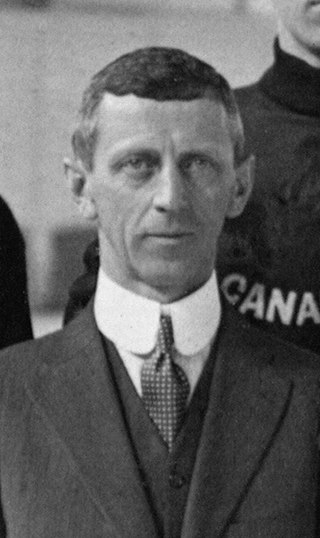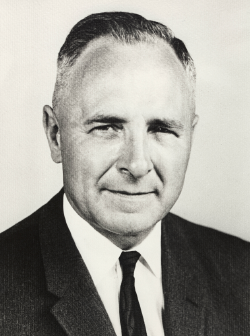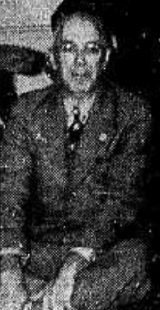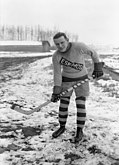
The Edmonton Eskimos were a Canadian amateur and later professional men's ice hockey team that existed from 1911 to 1927. After playing in senior hockey in the Alberta-based Big-4 League, the Eskimos joined the Western Canada Hockey League (WCHL) for the inaugural 1921–22 WCHL season, and played for the Stanley Cup against the Ottawa Senators in the 1923 Stanley Cup Finals, as the WCHL Champions. Team alumni include Hockey Hall of Fame members Eddie Shore, Duke Keats and Bullet Joe Simpson.
The Western Canada Hockey League (WCHL), founded in 1921, was a major professional ice hockey league originally based in the prairies of Canada. It was renamed the Western Hockey League (WHL) in 1925 and disbanded in 1926.

The Calgary Stampeders were a defunct ice hockey team that was based in Calgary, Alberta, Canada. The team existed from 1938 until 1972, playing in various senior amateur and minor professional leagues during that time. In 1946, the Stampeders captured the Allan Cup as Canadian senior hockey champions, the first Alberta based club to do so.
The Western Canada Senior Hockey League was a senior ice hockey league that played six seasons in Alberta and Saskatchewan, from 1945 to 1951. The league produced the 1946 Allan Cup and the 1948 Allan Cup champions, and merged into the Pacific Coast Hockey League for the 1951–52 season.

The Calgary Tigers, often nicknamed the Bengals, were an ice hockey team based in Calgary, Alberta, Canada, from 1920 until 1927 as members of the Big-4 League, Western Canada Hockey League and Prairie Hockey League. The Tigers were revived in 1932, playing for a short-lived four years in the North Western Hockey League. They played their games at the Victoria Arena.

Russell "Barney" Stanley was a Canadian professional ice hockey forward who played for the Vancouver Millionaires of the Pacific Coast Hockey Association (PCHA) and the Calgary Tigers, Regina Capitals and Edmonton Eskimos of the Western Canada Hockey League (WCHL). He was the second head coach of the Chicago Black Hawks of the National Hockey League (NHL). He won the Stanley Cup with the Millionaires in 1915 and was inducted into the Hockey Hall of Fame in 1963.

The Canadian Amateur Hockey Association was the national governing body of amateur ice hockey in Canada from 1914 until 1994, when it merged with Hockey Canada. Its jurisdiction included senior ice hockey leagues and the Allan Cup, junior ice hockey leagues and the Memorial Cup, amateur minor ice hockey leagues in Canada, and choosing the representative of the Canada men's national ice hockey team.

Hockey Alberta is the governing body of all ice hockey in Alberta, Canada and is affiliated with Hockey Canada. It was founded in 1907 as the Alberta Amateur Hockey Association (AAHA) to be the governing body for Alberta intra-city ice hockey play. As of the 2018–19 hockey season, the Chair of the Board of Directors was Terry Engen, and the Chief Executive Officer for operations management was Rob Litwinski.

William Abraham Hewitt was a Canadian sports executive and journalist, also widely known as Billy Hewitt. He was secretary of the Ontario Hockey Association (OHA) from 1903 to 1966, and sports editor of the Toronto Daily Star from 1900 to 1931. He promoted the establishment of the Canadian Amateur Hockey Association (CAHA), then served as its secretary-treasurer from 1915 to 1919, registrar from 1921 to 1925, registrar-treasurer from 1925 to 1961, and a trustee of the Allan Cup and Memorial Cup. Hewitt standardized player registrations in Canada, was a committee member to discuss professional-amateur agreements with the National Hockey League, and negotiated working agreements with amateur hockey governing bodies in the United States. He oversaw referees within the OHA, and negotiated common rules of play for amateur and professional leagues as chairman of the CAHA rules committee. After retiring from journalism, he was the managing-director of Maple Leaf Gardens from 1931 to 1948, and chairman of the committee to select the inaugural members of the Hockey Hall of Fame in 1945.

Claude Copeland Robinson was a Canadian ice hockey and sports executive. After winning an intermediate-level championship as captain of the Winnipeg Victorias in 1905, he served as secretary-treasurer and as vice-president of the Victorias. He coached the Victorias to a Manitoba Hockey League championship in 1909, and felt that his team could have competed for the newly established Allan Cup, despite that challenges from senior ice hockey teams were accepted only from Eastern Canada at the time. The Victorias won the Allan Cup by default in 1911, when the Toronto St. Michael's Majors refused to play, then successfully defended four challenges for the trophy.

James Lloyd Turner was a Canadian ice hockey manager and executive. He was born in Elmvale, Ontario.

Allan Wilfrid Pickard was a Canadian ice hockey administrator, who served as president of the Canadian Amateur Hockey Association (CAHA) from 1947 to 1950. When Canada opted out of the 1947 Ice Hockey World Championships and decided not to participate in the 1948 Winter Olympics, Pickard felt that Canada was obliged to send a team due to its place as a top hockey nation, and nominated the Ottawa RCAF Flyers who won the gold medal for Canada and lived up to the requirements of the Olympic Oath as amateurs. Despite disagreement with the International Olympic Committee, he sought for the International Ice Hockey Federation to adopt the CAHA definition of amateur in the face of increasing difficulty in selecting the Canada men's national ice hockey team.
The Wheat City Hockey Club was an early amateur ice hockey club in Brandon, Manitoba. The club fielded senior-level, junior and intermediate teams from 1898. The club fielded teams in the Manitoba & Northwestern Hockey Association, followed by the Manitoba Hockey Association, the Manitoba Professional Hockey League (MPHL) and the early Manitoba Hockey League.

William John Tobin was a Canadian ice hockey player, executive and head coach. He was a senior executive with the Chicago Black Hawks for the team's first 36 years of existence, also serving as coach for parts of two seasons. From 1946 to 1950, he was also the team's principal owner.
The Alberta Rugby Football Union was formed on September 25, 1911, and governed the newly emerging and evolving sport of football in the province for over 2 decades before it was disbanded in 1936. First the Calgary Rugby Football Union (CRFU) was created on September 29, 1908. The CRFU would play the champion from Edmonton to determine the winner of the Alberta Rugby Football League for 4 seasons from 1907 to 1910. After that the Alberta Rugby Football Union was formed in 1911. It joined the Manitoba Rugby Football Union and the Saskatchewan Rugby Football Union to form the Western Canada Rugby Football Union (WCRFU) in 1911.

Frank Ernest Sandercock was a Canadian ice hockey administrator. He served as president of both the Canadian Amateur Hockey Association and the Alberta Amateur Hockey Association, and had previously been an executive with the Ontario Hockey Association and founded a hockey organization to operate leagues in Calgary. He was an early proponent of junior ice hockey and senior ice hockey in Alberta, fostered growth in the game, and sought to reinvest profits into minor ice hockey for the younger generation.

Arthur Thomas Potter was a Canadian ice hockey administrator. He was president of the Canadian Amateur Hockey Association (CAHA) from 1962 to 1964, and oversaw the establishment of a permanent Canada men's national ice hockey team after he decided that sending the reigning Allan Cup champion to international competitions was no longer the answer. He felt that Canada needed discipline to handle Cold War tactics and propaganda at the Ice Hockey World Championships, sought to give its best players to develop as a team, and supported a plan by Father David Bauer to assemble a team of amateur student athletes to complete at the 1964 Winter Olympics.

Harry John Sterling was a Canadian ice hockey administrator. He was elected president of the Canadian Amateur Hockey Association (CAHA) in 1920, after serving as an Ontario Hockey Association executive and as president of the Thunder Bay Amateur Hockey Association. He declared that the CAHA would not tolerate the hockey "tourist" after becoming suspicious of players who changed their addresses to be on a new team. His investigation into registrations led to the suspension of a team from Saskatoon when it was discovered that players who won the gold medal representing Canada in ice hockey at the 1920 Summer Olympics were being paid for amateur hockey. His term as president resulted in the CAHA enacting stricter rules for registration and co-operation with the Amateur Athletic Union of Canada to investigate into all Canadian hockey players to maintain amateurism.

Frederick Everett Betts was a Canadian ice hockey administrator and businessman. He concurrently served as president of the Canadian Amateur Hockey Association (CAHA), the Saskatchewan Amateur Hockey Association, and the Saskatchewan branch of the Amateur Athletic Union of Canada during the 1919–20 season. He sought regulations to govern amateur sport in Canada, which he felt was in a state of disrepute due to the lack of discussion and the postponement of meetings during World War I. He supported the reinstatement of former professionals as amateur athletes as favoured in Western Canada, despite the growing rift with delegates from Eastern Canada on the issue. He sought for the Allan Cup trustees to allow the CAHA to have more say into how the national playoffs were operated and argued for receiving an annual percentage of profits from gate receipts to allow the CAHA to govern effectively.

Frederick Paul Henry Marples was a Canadian sports executive in ice hockey and athletics. He was president of the Winnipeg Monarchs team which won Winnipeg Amateur Hockey League championships in 1914 and 1915, and the Allan Cup as senior ice hockey champions of Canada. His operation of a reserve team to support the Monarchs led to debates on player eligibility for the Allan Cup and calls for a national governing body of hockey. As the secretary-treasurer of the Winnipeg Amateur Hockey League, he helped establish both the Manitoba Amateur Hockey Association (MAHA) and the Canadian Amateur Hockey Association (CAHA) in 1914; then served as secretary-treasurer of the MAHA from 1914 to until 1934, and as secretary of the CAHA from 1926 to 1945. He sought to grow the game in rural regions of Manitoba, promote minor ice hockey as a source of future senior players, to keep players in junior ice hockey until age 21, and was against the exodus of amateur players to professional teams.





















